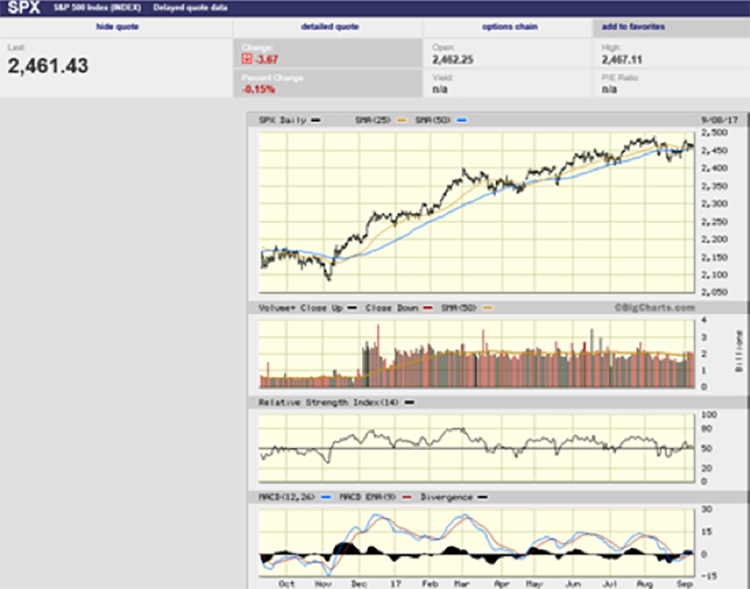by Jeffrey Saut, Raymond James
September 11, 2017
Noah had lived to a very great age when the flood of waters came upon the earth. And God said to Noah:
Come into the ark, you and all who are with you. Seven days from now I will cause it to rain upon the earth for forty days and forty nights. And every living thing I have made, I will destroy from off the face of the earth.
And Noah did all that the Lord had commanded him. He entered the ark with Shem and Ham and Japheth, his sons, his own wife and the wives of his sons. Birds and beasts and creeping things of every kind came to Noah and went into the ark, two by two, the male and the female, as God has commanded.
The Lord shut Noah in the ark, and the waters of the flood were upon the earth. All the fountains of the great deep were broken up and the windows of heaven opened. The rain fell upon the earth forty days and forty nights. The waters swelled and lifted the ark above the earth.
The flood spread and the waters continued to rise upon the earth, and the ark floated upon the water. . . . Every living thing that moved upon the earth died; birds, cattle, beasts, every creeping thing that creeps upon the earth, and every man. All in whose nostrils was the breadth of life, every man, every living thing, which was upon the face of the ground was destroyed. Only Noah, and those who were with him, remained alive.
. . . Genesis
So, I am sitting here in downtown Saint Petersburg, Florida at 7:30 a.m. Sunday morning awaiting the “great flood.” It was just a few days ago the computer models had hurricane Irma heading up the east coast of Florida, but Irma changed her mind. As we said in last Friday’s verbal strategy comments, “Batten down the hatches and rig for heavy weather!” As we write the storm is slated to hit Saint Petersburg early Monday morning with diminished winds of 80 – 110 MPH with subsequent power blackouts, so this may be the last missive of the week. We have done all we can do to protect ourselves and our property. The hurricane shutters have been put up on the lower level of our house (I do not climb on ladders anymore because I know too many friends that have been seriously injured from falling off of ladders, so the upper level of our house will just have to weather the storm on its own), the generator works, the bathtubs are full, the boat is tied down, and we have umbrellas.
We still are of the belief that investors need to break out their collective “umbrellas” on a near-term basis, for our short-term timing model has flipped back to a bearish configuration suggesting that if there is going to be a pullback the next two weeks are the likeliest timeframe. Longer term we think such a retracement is healthy for the continuation of the secular bull market that should have years left to run. And with that we leave you with these thoughts from Mick St. Amour of the esteemed firm of Robert Thompson and Associates. To wit:
Market indicators suggest some short-term hesitation or lack of risk appetite with equities, but any pause or short-term pullback that could develop in the coming weeks most likely confined to the 2300-2400 zone for the S&P 500 before we begin a year-end rally.
Risk appetite for equities typically follows credit markets. Lately credit markets show some hesitation when we look at high yield debt and demand for credit default swaps. Strong risk appetite for equities typically occurs when demand for CDX is trending lower but as you will see below CDX is no longer trending lower and perhaps beginning to trend higher.
But PMIs above 50 and strength in industrial metals suggest an economy that remains in expansion and potential for upside surprises for earnings per share so [the author believes] any short-term equity market weakness should be bought.
A weaker dollar is a tailwind for earnings.
Stock market breadth when we look at the NYSE Advance/Decline Line suggest more shallow pullbacks for equities. In fact the Advance/Decline line (blue line) is starting to outperform the S&P 500 (black line) suggesting strength beneath the surface.
BOTTOM LINE: Credit market indicators suggest some short-term hesitation with equities. But PMIs and strength in industrial metals along with a weaker dollar suggest potential upside surprises for earnings the rest of the year. Stock market breadth indicates strength beneath the surface and [the author believes] whatever short-term weakness we could see in the coming weeks should be bought. [The author believes] odds are pullbacks likely to be shallow for equities and expect a year-end rally most likely to start around the beginning of the 4th quarter as it usually does.
Preferred sectors right now are healthcare (where we are most overweight in our models), technology, basic materials, industrials, home construction, and utilities. In the short term we may be looking to flip our exposure in financials to utilities. Utilities and other interest sensitive groups seem to be rallying on the assumption that higher rates are less of a concern right now given diminished prospects for fiscal stimulus before the end of the year and expectations that additional Fed hikes most likely pushed into 2018.
We concur with the wisdom offered above. Otherwise, outside of any short-term pause and or pullback we might see for equities in the coming weeks the main and bigger move for global equities remains higher so stay bullish!
The call for this week: If there is going to be a short-term pullback the next two weeks are the likeliest timeframe.
*****
Additional information is available on request. This document may not be reprinted without permission.
Raymond James & Associates may make a market in stocks mentioned in this report and may have managed/co-managed a public/follow-on offering of these shares or otherwise provided investment banking services to companies mentioned in this report in the past three years.
RJ&A or its officers, employees, or affiliates may 1) currently own shares, options, rights or warrants and/or 2) execute transactions in the securities mentioned in this report that may or may not be consistent with this report’s conclusions.
The opinions offered by Mr. Saut should be considered a part of your overall decision-making process. For more information about this report – to discuss how this outlook may affect your personal situation and/or to learn how this insight may be incorporated into your investment strategy – please contact your Raymond James Financial Advisor.
All expressions of opinion reflect the judgment of the Equity Research Department of Raymond James & Associates at this time and are subject to change. Information has been obtained from sources considered reliable, but we do not guarantee that the material presented is accurate or that it provides a complete description of the securities, markets or developments mentioned. Other Raymond James departments may have information that is not available to the Equity Research Department about companies mentioned. We may, from time to time, have a position in the securities mentioned and may execute transactions that may not be consistent with this presentation’s conclusions. We may perform investment banking or other services for, or solicit investment banking business from, any company mentioned. Investments mentioned are subject to availability and market conditions. All yields represent past performance and may not be indicative of future results. Raymond James & Associates, Raymond James Financial Services and Raymond James Ltd. are wholly-owned subsidiaries of Raymond James Financial.
International securities involve additional risks such as currency fluctuations, differing financial accounting standards, and possible political and economic instability. These risks are greater in emerging markets.
Investors should consider the investment objectives, risks, and charges and expenses of mutual funds carefully before investing. The prospectus contains this and other information about mutual funds. The prospectus is available from your financial advisor and should be read carefully before investing.
Copyright © Raymond James























